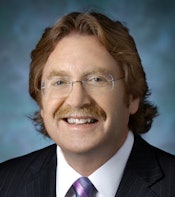
Last year, Dr. Elliot Fishman of Johns Hopkins University started a lecture series that draws experts from industries unrelated to healthcare to speak about innovations that could improve the patient experience. Past lecturers have included Bill Phillips, editor in chief of Men's Health; Paul Greenberg, former CEO of CollegeHumor; Cindy Wolf, executive chef and restaurateur; and Horst Schulze, chairman and CEO of the Capella Hotel Group.
In April 2014, the featured speaker was Ed Catmull, PhD, president of Pixar and Disney Animation Studios, who offered his perspective on how lessons learned at Pixar could influence the practice of radiology. His remarks were recently published online in an article in the Journal of the American College of Radiology (February 20, 2015). AuntMinnie.com spoke with Dr. Fishman about Catmull's talk.
AuntMinnie: Why did you start this lecture series?
 Dr. Elliot Fishman from Johns Hopkins University.
Dr. Elliot Fishman from Johns Hopkins University.Fishman: At a weekend faculty retreat last year, we began discussing patients' experience in our department, and asking ourselves what we are doing to improve it. Out of that weekend came the idea of a lecture series that would invite experts from other industries to speak on what consumers want and how to run a business to best serve them. We wanted to hear from people outside of medicine. Our goal was to inspire staff to rethink how we do things in our department -- and not just radiologists, but also other physicians, technologists, and nurses.
The series is great. We don't record the lectures, so they're like rock concerts -- if you don't go, you miss it.
How did you come to invite Ed Catmull?
I've known Ed for a long time. I met him in the mid-1980s, when Pixar was looking to spin off from Lucasfilm. They were interested in 3D imaging, and a friend of mine who worked for Siemens Healthcare told them to call me -- and I spent the next five years working with Pixar. When Ed came to speak last year he'd just published his book, Creativity, Inc., so he was on every TV program everywhere.
In his lecture, Catmull said the mindset of "avoiding mistakes is paramount" is counter to long-term success. How does that translate to radiology?
 Ed Catmull, PhD. Original photo (VES_Awards_89) by and copyright of Jeff Heusser on flickr. Cropped and used according to CC BY 2.0 license.
Ed Catmull, PhD. Original photo (VES_Awards_89) by and copyright of Jeff Heusser on flickr. Cropped and used according to CC BY 2.0 license.His point was that if there's no room for error, it's hard to move forward and find new success. For radiology, we're not talking about taking risks and reading exams incorrectly. But you can read an exam perfectly, and if the front desk is rude to a patient, you've lost that person.
Ed spoke about the mistakes Pixar has made, and how there's a misconception that all these hit films were successes right away. But that's not true. And if you make a great movie, you can't stop there -- you have to try to make the next movie even better. So here at Johns Hopkins, we can't instantly make our patients' experience perfect, but we can keep developing new ideas and working with improvements.
Catmull spoke about hidden aspects of an organization and how it's easy for different members to become alienated from each other. Do you see this in the radiology department?
Sure. In most departments, the focus is on radiologists and their decisions, and the fact that the department depends on all kinds of staff gets lost. My success as the physician is dependent on our technologists, our scheduling people, and the front desk staff. It's like that Vidal Sassoon tagline: "If you don't look good, we don't look good" -- meaning that we all work together to create a successful patient experience.
Radiologists know what's happening in the reading room, but they aren't necessarily aware of patient-centric aspects of the department like scheduling, parking, checking in, having an intravenous line placed by a nurse, or requesting exam results. All of these are key to patients' experience, and if radiologists aren't aware of them, it can prevent necessary problem-solving.
Catmull noted that candor in an organization is crucial to its success, giving as an example a rift that occurred between film participants and production staff on Pixar's "A Bug's Life." Production staff felt they were regarded as second-class citizens -- but they hadn't voiced this concern. Again, how might the value of candor translate to radiology?
We have to meet and talk about issues differently. As I said in the JACR article, it's dangerous when everyone in a meeting is afraid to speak up or voice their concerns, but once the meeting is over, they talk to one another about the real issues. Real concerns need to be addressed and corrected early, and the fact is that we're responsible for patients' entire experience -- we can't say some part of it is someone else's problem and just ignore it.




















